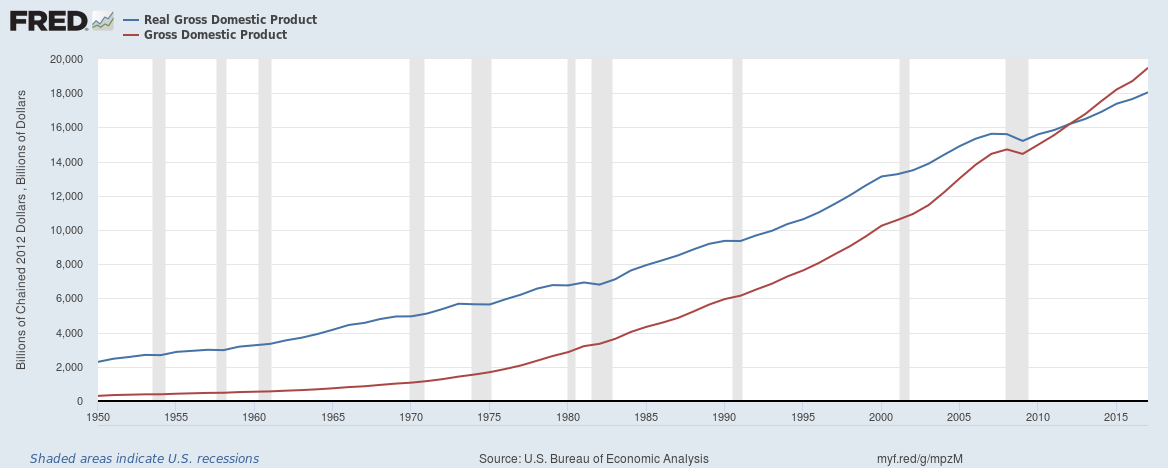Nominal GDP vs Real GDP
Nominal GDP tells about the current market value of final goods and services produced in an economy. Real GDP, on the other hand, is a measure of total production at constant prices. Change in real GDP over the period is a measure of growth.
Nominal GDP data series represents the combined effect of changes in quantities of goods and services and their associated price changes, but the real GDP keeps the prices constant and measure only changes in quantities of goods and services. Since the real GDP removes the effect of price changes, it is a better measure of an economy’s growth rate.
Nominal GDP is sometimes referred to just as gross domestic product (GDP).
The following approximate relationship can be established between change in nominal GDP ($Y) and change in real GDP (Y):
$$ \text{Change in Nominal GDP}\ \\=\ \text{Change in Average Prices}+\text{Change in Real GDP} $$
The ratio of nominal GDP to real GDP is called GDP deflator which is a measure of price level:
$$ \text{GDP Deflator}=\frac{\text{Nominal GDP}}{\text{Real GDP}} $$
This relation is also useful is converting nominal GDP to real GDP:
$$ \text{Real GDP}=\frac{\text{Nominal GDP}}{\text{GDP Deflator}} $$
Example
Let’s consider an economy which produces 1 million cars in 2010 when one car is priced at $10,000 on average. Market value of production (and consumption) of cars in 2010 is hence $10 billion (=1,000,000 × $10,000). If the average price of a car changes to $11,000 in 2015 but the quantity produced remains the same i.e. stays 1 million, the market value of cars produced in 2015 works out to $11 billion (=1,000,000 × $11,000). Just because there is an increase in dollar value of production of car doesn’t mean that the economy’s overall production has increased. The nominal growth of 10% over the five-year period results solely from increase in prices. If we consider 2010 as the base year, the real GDP for 2015 would be $10 billion (i.e. 1 million cars valued at 2010 average price of $10,000). It shows that there is no increase in actual production and hence real growth is zero.
The following chart obtained from Federal Reserve Bank of St. Loius FRED shows comparison between nominal GDP and real GDP. The base year for this data series is 2012 this is why the blue line representing real GDP is above the red line representing nominal GDP for periods before 2012 and vice versa for periods after 2012.

Following are the main differences between nominal GDP and real GDP:
- Nominal GDP is higher than real GDP when inflation is positive and lower than real GDP when there is deflation i.e. when average prices fall.
- Nominal GDP includes the effect of both changes in prices and changes in total production while real GDP accounts only for changes in quantities produced.
- Nominal GDP must be dissected to work out growth rate while real GDP values can be used directly to calculate growth rate.
- Nominal GDP is lower GDP than real GDP in periods that fall before the base year and higher than real GDP in periods that fall after the base year.
by Obaidullah Jan, ACA, CFA and last modified on